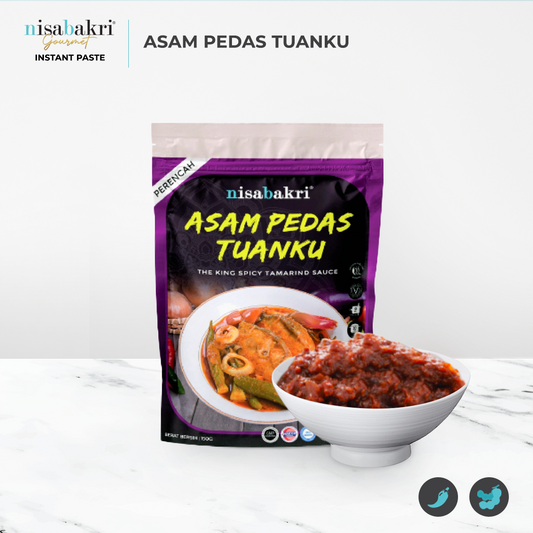Asam Pedas is a popular dish from Malaysia and Indonesia that is known for its sour and spicy flavor. Asam Pedas is typically served with steamed rice and is often garnished with fresh herbs such as coriander and Thai basil. It is a flavorful and satisfying dish that is enjoyed by many in Southeast Asia and beyond.

What is Asam Pedas?
Asam Pedas is a traditional Malay dish, consisting of a fish stewed in a spicy and tangy gravy. The key ingredients in Asam Pedas are tamarind, chili, and various spices such as lemongrass, ginger, garlic, and shallots. These ingredients are combined with the meat or fish and cooked in a broth until tender.
How to prepare the ingredients before making Asam Pedas?
Before making Asam Pedas, there are several ingredients that need to be prepared. Here are the steps to prepare the key ingredients:
Tamarind:
Soak a small ball of tamarind in warm water for about 10 minutes, then use your fingers to squeeze the pulp from the seeds. Strain the pulp and discard the seeds.
Chilies:
Remove the stems from the chilies and chop them into small pieces. You can use any type of chili that you prefer, depending on how spicy you want the dish to be.
Lemongrass:
Cut off the root end and the tough top part of the lemongrass stalks, leaving only the tender middle section. Bruise the stalks by hitting them with the back of a knife or a rolling pin to release their flavor.
Ginger and Garlic:
Peel and chop the ginger and garlic into small pieces.
Shallots:
Peel and chop the shallots into small pieces.
Fish or Meat:
Clean the fish or meat and cut it into bite-sized pieces.
Once these ingredients are prepared, you can start cooking the Asam Pedas by sautéing the shallots, garlic, and ginger in oil until fragrant, then adding the chilies, lemongrass, and spices. Add the tamarind pulp and water or coconut milk, and bring the mixture to a simmer before adding the fish or meat. Cook until the fish or meat is tender and the flavors have melded together.
What are the Steps to Make Asam Pedas?
Here are the general steps to make Asam Pedas:
Ingredients:
|
500g fish (such as mackerel, snapper, or catfish)
|
|
2 tbsp tamarind pulp
|
|
4-5 red chilies, chopped
|
|
2 stalks lemongrass, bruised
|
|
3 cloves garlic, chopped
|
|
3 shallots, chopped
|
|
1 inch ginger, chopped
|
|
1 tsp turmeric powder
|
|
1 tsp salt
|
|
2 cups water
|
|
2 tbsp oil
|
Instructions:
-
Prepare the fish by cleaning it and cutting it into bite-sized pieces. Set aside.
-
Soak the tamarind pulp in 1/2 cup of warm water for about 10 minutes. Once softened, use your fingers to extract the pulp from the seeds. Discard the seeds and set the tamarind pulp aside.
-
Heat the oil in a large pot or wok over medium-high heat. Add the garlic, shallots, and ginger, and stir-fry until fragrant and lightly browned.
-
Add the chopped chilies, turmeric powder, and lemongrass, and stir-fry for another minute or until the mixture is fragrant.
-
Add the fish pieces to the pot and stir gently to coat them with the spice mixture.
-
Pour in the tamarind pulp mixture, water, and salt. If desired, add sugar to balance the sourness of the tamarind.
-
Bring the mixture to a boil, then reduce the heat to low and let it simmer for 10-15 minutes, or until the fish is cooked through and the broth has thickened slightly.
-
Taste the broth and adjust the seasoning as needed. You can add more salt, sugar, or tamarind juice to taste.
-
Serve hot with steamed rice, and garnish with chopped coriander or Thai basil, if desired.
How to store freshly made Asam Pedas for longer?
If you have leftover Asam Pedas or would like to store freshly made Asam Pedas for longer, here are some tips to help you do so:
-
Asam Pedas should be refrigerated within two hours of cooking. Transfer the Asam Pedas to a clean and airtight container, and store it in the refrigerator.
-
Asam Pedas can also be frozen for longer storage. Allow the Asam Pedas to cool to room temperature, transfer it to a freezer-safe container, and store it in the freezer for up to three months.
Conclusion:
Asam Pedas is a delicious and popular Malaysian dish that consists of fish or seafood cooked in a tangy and spicy tamarind-based gravy. If you want to buy tasty Asam Pedas you can visit https://www.nisabakrigourmet.com/ for high-quality products.
FAQ:
1. How do I cook the fish in Asam Pedas without overcooking it?
For Asam Pedas, it is best to use firm and fleshy fish that can hold their shape during cooking. Avoid using delicate and flaky fish like tilapia or cod, which can easily fall apart. To prevent overcooking the fish, add it towards the end of the cooking process, once the gravy has simmered and the vegetables have softened. This will allow the fish to cook gently and absorb the flavors of the gravy without becoming too dry or mushy.
Once the fish is added, reduce the heat to a gentle simmer and cook for a few minutes until the fish is just cooked through. Be careful not to boil the fish vigorously as this can cause it to break apart.
2. Can I make a vegetarian or vegan version of Asam Pedas?
Yes, it is possible to make a vegetarian or vegan version of Asam Pedas by substituting the fish or seafood with plant-based ingredients.
3. How do I adjust the spiciness level of Asam Pedas to my liking?
Asam Pedas is known for its spicy and tangy flavor, but the level of spiciness can be adjusted to your liking. Chili peppers are the main ingredient that gives Asam Pedas its spiciness. If you prefer a milder taste, use fewer chili peppers or remove the seeds and membranes which contain most of the heat. Vegetables like tomatoes and okra can help balance the spiciness of Asam Pedas.
4. Can I make a larger batch of Asam Pedas and store it for later?
Yes, you can make a larger batch of Asam Pedas and store it for later. Let the Asam Pedas cool to room temperature and transfer it to an airtight container. Store in the refrigerator for up to 3-4 days. To make it easier to store and reheat, consider portioning the Asam Pedas into smaller containers or freezer bags.



